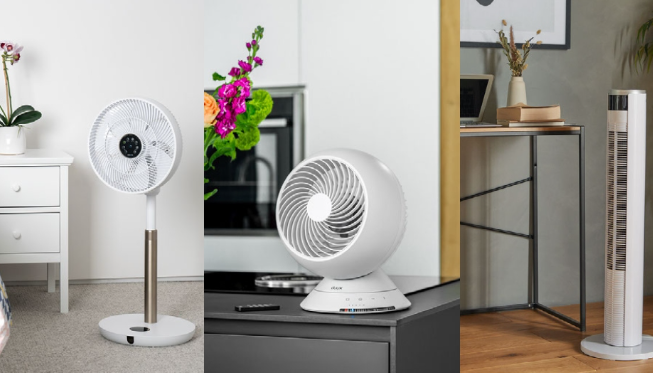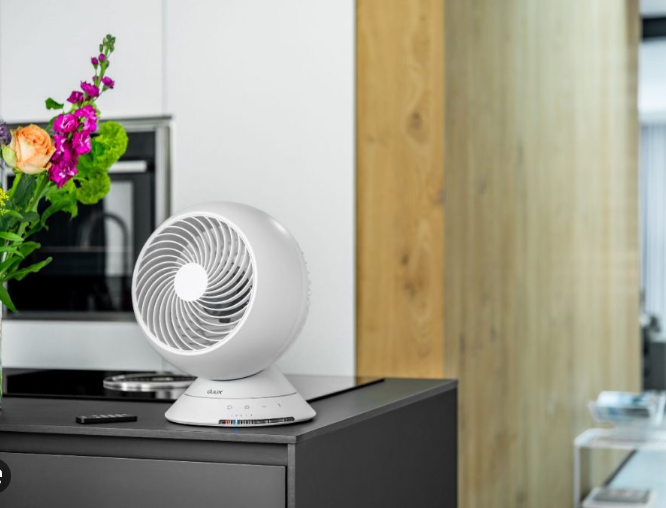When seeking top-tier cooling solutions, Dyson electric fans stand out with their bladeless design, advanced features, and sleek aesthetics. But with their premium price, are they truly the best electric fan for your needs? This Dyson electric fan review examines the pros and cons of Dyson’s top models for 2025, focusing on their cooling performance, features, and overall value. From electric fan setup to electric fan troubleshooting, we’ll guide you through deciding if a Dyson fan is right for your home. Our electric fan tips will help you maximize cooling efficiency and maintain performance.
Why Consider a Dyson Electric Fan?
Dyson electric fans use Air Multiplier™ technology to deliver smooth, powerful airflow without traditional blades, offering a safer and more stylish cooling option. Many models combine cooling with air purification or heating, making them versatile for year-round use. Consuming 20-56 watts (about 1-2 cents per hour), they’re energy-efficient, though their price range ($250-$800) reflects premium features like HEPA filters and smart controls. This Dyson electric fan review evaluates whether their performance justifies the cost compared to conventional fans.
Pros of Dyson Electric Fans
Dyson fans offer unique advantages that set them apart from traditional models. Here are the key benefits:
- Bladeless Safety: No spinning blades, making them safe for children and pets while reducing dust buildup for easier cleaning.
- Effective Airflow: Air Multiplier™ technology provides smooth airflow (up to 500 liters per second), ideal for small to medium rooms (100-300 sq ft).
- Quiet Operation: Low settings operate at 25-40 dB, perfect for bedrooms or offices, with sleep modes for minimal disturbance.
- Multifunctional Design: Models like the Dyson Purifier Hot+Cool offer cooling, heating, and air purification, reducing the need for multiple devices.
- Smart Features: App and voice control (via MyDyson app, Alexa, or Google Assistant) enable remote adjustments and air quality monitoring.
- Modern Aesthetics: Sleek, minimalist designs complement contemporary homes, with slim profiles for tight spaces.
- User-Friendly: Magnetic remotes and intuitive controls, with timers (15 minutes to 9 hours), enhance convenience and energy savings.
These features make Dyson fans a premium choice for those valuing safety, style, and versatility.
Cons of Dyson Electric Fans
Despite their strengths, Dyson fans have limitations to consider. Here are the key drawbacks:
- High Price: Ranging from $250-$800, Dyson fans are significantly more expensive than standard fans ($15-$150), which may not align with their cooling output.
- Limited Cooling Power: Fans circulate air rather than lower room temperature, less effective in extreme heat or high humidity compared to air conditioners.
- Lower Airflow for Cost: Airflow (1000-1500 CFM) is often less than budget high-velocity fans (3000-7000+ CFM) at a fraction of the price.
- Noise at High Speeds: While quiet on low (25-40 dB), higher settings (50-60 dB) can be disruptive for sleep or quiet settings.
- Complex Cleaning: Air inlets at the base can collect dust or pet hair, requiring careful cleaning to maintain airflow.
- Durability Issues: Some users report motor failures or cosmetic wear (e.g., paint chipping) within 1-2 years, with variable customer service support.
- Basic Models Lack Smart Features: Entry-level models like the Dyson Cool CF1 lack app connectivity, limiting convenience for their price.
These cons highlight the need to balance premium features against cooling needs and budget.
Electric Fan Setup: Getting Started
Proper electric fan setup ensures your Dyson fan performs at its best. Follow these steps:
- Unpack and Inspect: Verify all components, including the base, remote, and filters, are included and undamaged.
- Assemble Securely: Snap or screw the base into place as per the manual, ensuring stability.
- Position Strategically: Place on a flat surface in a corner or near a window to maximize airflow. Avoid obstructions like furniture.
- Plug In and Test: Connect to power, pair with the MyDyson app (if applicable), and test speeds, oscillation, and timer settings.
Positioning opposite a wall or at a 90-degree angle enhances air circulation. Ensure stability to prevent tipping in busy households.

How to Use a Dyson Electric Fan Effectively
Maximize cooling with these electric fan tips:
- Use Oscillation: Enable 70-350 degree oscillation to distribute air evenly across the room.
- Create a Cross-Breeze: Place near an open window to pull in cooler air or pair with a bowl of ice for a chilled effect.
- Adjust Speeds: Use low speeds (1-3) for quiet operation during sleep and higher speeds (7-10) for quick cooling.
- Leverage Timers: Set timers (15 minutes to 9 hours) to save energy, especially for nighttime use.
- Use Auto Mode: On smart models, auto mode adjusts speed based on air quality or temperature for efficient cooling.
Pairing with an air conditioner can enhance cooling, allowing you to raise the AC temperature and save energy.
Electric Fan Maintenance: Keeping Your Dyson in Top Shape
Regular electric fan maintenance ensures longevity and performance. Follow these steps:
- Clean Regularly: Dust or pet hair can clog air inlets, reducing airflow. See our electric fan cleaning guide below.
- Inspect Cords: Check for fraying or damage to the power cord or plug. Stop using if issues are found.
- Replace Filters: For purifying models, replace HEPA or carbon filters every 12 months or when prompted by the app.
- Store Properly: Store in a dry, dust-free area when not in use to protect components.
Consistent maintenance minimizes issues like clogged inlets and ensures efficient operation.
How to Clean a Dyson Electric Fan
Electric fan cleaning is essential for maintaining airflow and air quality. Here’s how to clean your Dyson fan:
- Unplug the Fan: Disconnect from power to ensure electric fan safety.
- Remove Filters: For purifying models, remove HEPA or carbon filters as per the manual.
- Clean Air Inlets: Use a dry cloth or vacuum with a soft brush to remove dust from base inlets. Avoid damp cloths to prevent clogs.
- Wipe Exterior: Clean the bladeless loop and body with a dry or slightly damp cloth, ensuring no water enters electronics.
- Reassemble and Test: Reinstall filters and test all functions to confirm proper operation.
Clean every 2-4 weeks during heavy use to prevent dust buildup and maintain performance.
Electric Fan Troubleshooting: Fixing Common Issues
Even the best electric fan may face problems. Here’s a guide to electric fan troubleshooting for Dyson models:
- Fan Won’t Start: Check the power cord, plug, or outlet. Test the outlet with another device.
- Weak Airflow: Clogged inlets or filters can reduce performance. Clean thoroughly or replace filters.
- High-Pitched Noise: Dust or debris in the motor may cause noise. Clean inlets or contact support.
- Error Codes (e.g., F4): Indicates motor issues. Unplug for 10 minutes to reset, or contact support for repairs.
If issues persist, Dyson’s warranty (typically 2 years) may cover repairs, though customer service experiences vary.
Electric Fan Safety: Staying Safe
Electric fan safety is a key strength of Dyson’s bladeless design. Follow these guidelines:
- Avoid Water: Keep fans away from water or damp areas to prevent electrical hazards.
- Child and Pet Safety: Bladeless design minimizes risks, but ensure the fan is stable to prevent tipping.
- Limit Continuous Use: Use timers to avoid overnight operation, reducing overheating risks.
- Inspect Regularly: Check cords and components for wear before use.
These precautions ensure safe operation of your Dyson fan.

Top Dyson Electric Fans for 2025
Based on recent testing and user feedback, here are the top Dyson electric fans for 2025, evaluated for cooling power, features, and value:
- Dyson Cool CF1 Desk Fan: This compact desk fan (10 x 10 x 24 inches, 5.5 pounds) delivers 500-1000 CFM with 10 speeds and three oscillation settings (45, 90, 180 degrees). Quiet at 29 dB with a 1-9 hour timer, it’s energy-efficient (30 watts max). Pros: Stylish, quiet, powerful for size. Cons: No app connectivity, finicky remote. Best for: Small rooms or offices.
- Dyson Purifier Cool Gen1 TP10 (Tower): This 41-inch fan (8 x 8 x 41 inches, 10.8 pounds) offers 1000-1500 CFM with 10 speeds, 70-degree oscillation, and a HEPA filter. Quiet at 30 dB with a 1-9 hour timer. Pros: Air purification, safe, quiet. Cons: Expensive ($500+), moderate airflow. Best for: Allergy sufferers.
- Dyson Purifier Hot+Cool Formaldehyde HP09 (Tower): This 30-inch fan (8 x 5 x 30 inches, 12.6 pounds) provides 1000-1500 CFM with 10 speeds, 350-degree oscillation, and heating/purifying capabilities. Quiet (30 dB) with app/voice control. Pros: Multifunctional, smart, quiet. Cons: High cost ($700+), complex cleaning. Best for: Year-round use.
- Dyson Cool AM07 Tower Fan: This 40-inch fan (7.5 x 4.3 x 39.6 inches, 6.3 pounds) offers 1000-1500 CFM with 10 speeds, 70-degree oscillation, and a 1-9 hour timer. Pros: Quiet (30-50 dB), sleek, affordable for Dyson ($400). Cons: No air purification, noisy at high speeds. Best for: Budget-conscious Dyson buyers.
- Dyson Purifier Humidify+Cool Formaldehyde (Tower): This 36-inch fan (12.3 x 11 x 36.3 inches, 18.3 pounds) delivers 1000-1500 CFM with humidification and air purification. Pros: Great for allergies, smart controls, quiet (30 dB). Cons: Expensive ($800+), heavy. Best for: Dry climates or allergy sufferers.
These models balance Dyson’s premium features with effective cooling, though their airflow may not match cheaper high-velocity fans.
Conclusion: Is a Dyson Electric Fan Worth It?
This Dyson electric fan review highlights the strengths and weaknesses of Dyson’s premium fans for 2025. Their bladeless design, quiet operation, and multifunctionality (cooling, heating, air purification) make them ideal for safety-conscious homes or allergy sufferers. However, their high cost, moderate airflow, and occasional durability issues may not suit everyone. By mastering electric fan setup, electric fan cleaning, and electric fan troubleshooting, you can maximize their performance. Prioritize electric fan safety and electric fan maintenance to ensure longevity. If style and multifunctionality are priorities, models like the Dyson Purifier Hot+Cool HP09 excel; for stronger airflow, consider budget alternatives. Choose the best electric fan for your needs and stay cool in style!